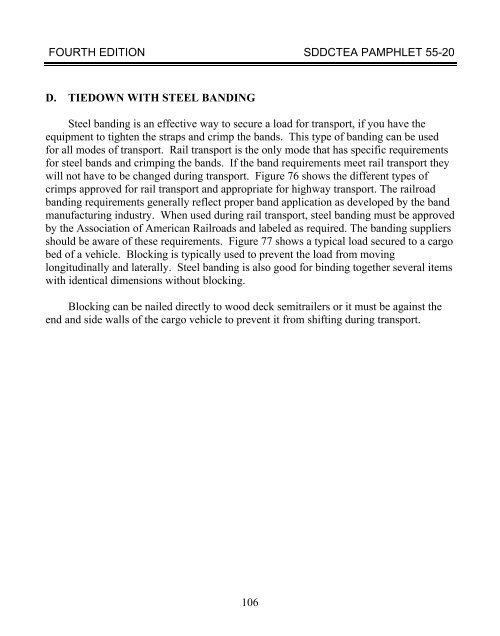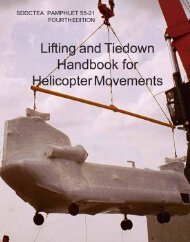TEA PAM 55-20 Tiedown Handbook for Truck - Military Surface ...
TEA PAM 55-20 Tiedown Handbook for Truck - Military Surface ...
TEA PAM 55-20 Tiedown Handbook for Truck - Military Surface ...
You also want an ePaper? Increase the reach of your titles
YUMPU automatically turns print PDFs into web optimized ePapers that Google loves.
FOURTH EDITION SDDC<strong>TEA</strong> <strong>PAM</strong>PHLET <strong>55</strong>-<strong>20</strong><br />
D. TIEDOWN WITH STEEL BANDING<br />
Steel banding is an effective way to secure a load <strong>for</strong> transport, if you have the<br />
equipment to tighten the straps and crimp the bands. This type of banding can be used<br />
<strong>for</strong> all modes of transport. Rail transport is the only mode that has specific requirements<br />
<strong>for</strong> steel bands and crimping the bands. If the band requirements meet rail transport they<br />
will not have to be changed during transport. Figure 76 shows the different types of<br />
crimps approved <strong>for</strong> rail transport and appropriate <strong>for</strong> highway transport. The railroad<br />
banding requirements generally reflect proper band application as developed by the band<br />
manufacturing industry. When used during rail transport, steel banding must be approved<br />
by the Association of American Railroads and labeled as required. The banding suppliers<br />
should be aware of these requirements. Figure 77 shows a typical load secured to a cargo<br />
bed of a vehicle. Blocking is typically used to prevent the load from moving<br />
longitudinally and laterally. Steel banding is also good <strong>for</strong> binding together several items<br />
with identical dimensions without blocking.<br />
Blocking can be nailed directly to wood deck semitrailers or it must be against the<br />
end and side walls of the cargo vehicle to prevent it from shifting during transport.<br />
106





